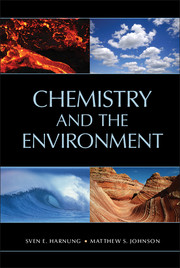Book contents
- Frontmatter
- Contents
- Preface
- Acknowledgments
- Chemistry and the Environment
- Introduction
- 1 The Earth
- 2 Environmental dynamics
- 3 The Spheres
- 4 Chemistry of the atmosphere
- 5 Chemistry of the hydrosphere
- 6 Chemistry of the pedosphere
- 7 Global cycles of the elements
- 8 The chemicals industry
- 9 Environmental impact of selected chemicals
- 10 The chemistry of climate change
- Appendix 1
- Appendix 2
- Appendix 3
- Appendix 4
- Appendix 5
- References
- Name index
- Subject index
- Miscellaneous Endmatter
4 - Chemistry of the atmosphere
Published online by Cambridge University Press: 05 November 2012
- Frontmatter
- Contents
- Preface
- Acknowledgments
- Chemistry and the Environment
- Introduction
- 1 The Earth
- 2 Environmental dynamics
- 3 The Spheres
- 4 Chemistry of the atmosphere
- 5 Chemistry of the hydrosphere
- 6 Chemistry of the pedosphere
- 7 Global cycles of the elements
- 8 The chemicals industry
- 9 Environmental impact of selected chemicals
- 10 The chemistry of climate change
- Appendix 1
- Appendix 2
- Appendix 3
- Appendix 4
- Appendix 5
- References
- Name index
- Subject index
- Miscellaneous Endmatter
Summary
The atmosphere interacts directly with the lithosphere, hydrosphere, biota, and society. Noble gases given off by radioactive decay in the core and crust have accumulated since the planet formed, with the exception of He, which has escaped to space. The exchange of water between the atmosphere and the oceans and the land is a key component of weather and the planetary heat engine (see Figure 3.3). The biosphere has dramatically changed the atmosphere's composition, including oxygen and the majority of trace gases. Human activities, such as agriculture, industry, and transportation, have left a clear mark on the composition and chemistry of the atmosphere. A summary of the gases found in the atmosphere is given in Section 3.3.
The state of the atmosphere affects us all. Crop yields depend on climate, rain, and nutrients present in rain, and on trace gases such as ozone and carbon dioxide. There are also direct effects: WHO estimates that between 2.5 and 11% of human deaths are due to exposure to air pollution. The thickness of the ozone layer at midlatitudes has decreased dramatically over the past generation, not to mention the Antarctic ozone hole. Climate change has important implications for the global ecosystem and public.
- Type
- Chapter
- Information
- Chemistry and the Environment , pp. 140 - 168Publisher: Cambridge University PressPrint publication year: 2012
- 1
- Cited by



